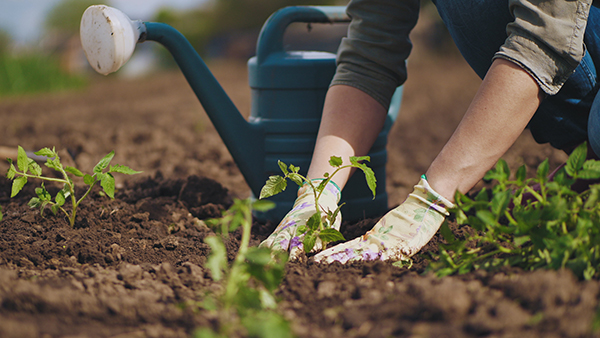Growing ginger at home: A guide to cultivating fresh ginger
03/19/2024 / By HRS Editors

Ginger is a versatile spice that deserves a space in your kitchen and prepper stockpile. If you want to stock up on ginger before SHTF, learn how to grow it in your home garden.
Alternatively, you can stock up on its other forms, like dried, powdered or crystallized ginger. (h/t to LoveTheGarden.com)
What is ginger?
The most common species of edible ginger is Zingiber officinale.
Ginger is a root vegetable that grows in Southeast Asia. It is often used in Indian and Asian cuisine and it adds a boost of flavor to various dishes. Ginger root is a versatile ingredient and you can use it fresh, powdered, dried, in oil or added to a juice or smoothie.
You can also grow ginger at home. However, because ginger is a tropical vegetable it will not survive frosty climates.
The best time to start planting ginger at home is in early spring, after the last of the frost.
Choose organic ginger for your home garden
To grow ginger, you will need a ginger root. You can buy organic ginger from the supermarket for best results.
Choose organic ginger that is plump but firm. Look for small “eyes” because these are the beginning of the shoots that your plant will grow from.
While you can plant the whole root, you can also divide the root into sections to create multiple plants. When cutting ginger, make sure each section has at least two to three eyes.
After dividing the root plant, set the ginger aside and let the pieces dry for several days. This will help the ginger pieces form a protective layer over the surface and heal, which is essential to reducing the risk of infection.
Each piece of cut ginger root will need at least 20 cm (eight inches) of space between them.
How to grow ginger at home
Ginger thrives in partial shade or areas with morning sun. Try to choose a location away from large roots and keep ginger sheltered from wind and moisture.
If you are growing ginger in a pot, choose one that is at least 30 cm (12 inches) deep. If growing in the ground, plant ginger at least 20 cm (eight inches) apart.
For best results, use a high-quality compost. Fill a seed tray with compost and place the ginger root on the surface.
Cover the ginger with a few centimeters of compost but make sure some of the root’s eyes are still showing. Water gently using a watering can with a nozzle full of small holes.
Place the tray in a warm, dry and sunlit place for several days to allow the shoots to develop.
Cover the lower part of the ginger shoots with more compost. When the shoots are growing strongly, move the whole ginger plant into a pot filled with compost. (Related: 12 Useful medicinal herbs to grow in your home garden.)
Leave the ginger plant indoors. Alternatively, you can plant it outdoors in a prepared bed filled with good compost after all risk of frost has passed.
After planting the ginger, keep the soil damp by watering lightly after planting. Check the ginger regularly and water when the soil starts drying out, but before it is completely dry.
If you notice poor draining in the soil, adjust watering so you water less to avoid soggy soil, which can cause rotting.
Harvest ginger by digging up the plant, washing it carefully and letting it dry thoroughly. Store ginger in a cool and dark room.
Check ginger regularly, especially through the cooler months. Bring ginger in during the winter, and keep the pot in a dry and warm area.
Where to get organic crystallized ginger
While waiting for ginger to grow in your garden, stock up on organic crystallized ginger.
Organic crystallized ginger is ideal if you find the flavor of raw ginger a bit too strong for your taste.
The Health Ranger Store is thrilled to introduce the Groovy Bee® Organic Crystallized Ginger – the ultimate healthy snack to satisfy your sweet tooth!
Made with organic, dehydrated, diced ginger slices that are slightly sweetened with organic cane sugar, our premium crystallized ginger pieces provide a sweet and easy way to add ginger to your diet.
An excellent addition to your favorite recipes or as a snack on its own, Groovy Bee® Organic Crystallized Ginger contains no gluten or GMOs and is certified Kosher and organic.
It is also plant-based, non-China and has been thoroughly lab-tested for glyphosate, heavy metals and microbiology.
Visit Health Ranger Store for other food items for your prepping stockpile and HomeGardeningNews.com for more tips on how to grow other herbs and spices in your garden.
Watch the video below for tips on how to repot potted plants with the sled method.
This video is from the MJTank channel on Brighteon.com.
More related stories:
Gardening 101: How to use fertilizer properly for healthy plants with better yields.
Prepper pharmacy: 17 Medicinal plants you can grow indoors year-round.
13 Things to add to your to-do list for summer gardening.
Prepper medicine: 9 Medicinal herbs to plant in your home garden.
Sources include:
Submit a correction >>
Tagged Under:
emergency food, food freedom, food supply, gardening tips, ginger, green living, Herbs, home gardening, homesteading, how-to, off grid, preparedness, prepper, prepping, raised bed garden, spices, survival, sustainable living, tips
This article may contain statements that reflect the opinion of the author
Get independent news alerts on natural cures, food lab tests, cannabis medicine, science, robotics, drones, privacy and more from NewsTarget.com
Get independent news alerts on natural cures, food lab tests, cannabis medicine, science, robotics, drones, privacy and more from NewsTarget.com
RECENT NEWS & ARTICLES
SHTF.News is a fact-based public education website published by SHTF News Features, LLC.
All content copyright © 2018 by SHTF News Features, LLC.
Contact Us with Tips or Corrections
All trademarks, registered trademarks and servicemarks mentioned on this site are the property of their respective owners.





















